Forest Creek Golf Club (North Course)
North Carolina, USA
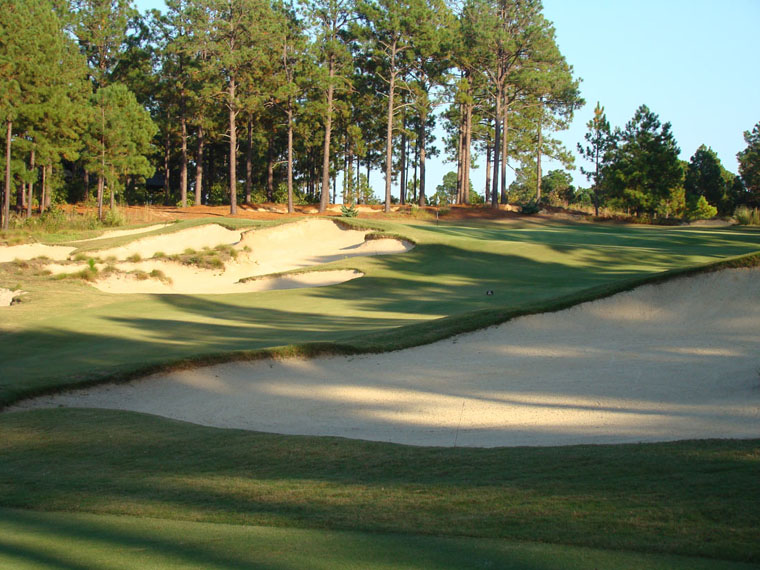
The companion course to the South Course was laid over hillier terrain. It features larger hazards, helping to reflect the fact that the course is laid out in The Sand Hills of North Carolina.
Tom Fazio’s career path has been the very blue print for success.
First, he apprenticed with an accomplished architect (his Uncle George), acquiring valuable expertise in the field working on diverse and premium projects like Butler National, Jupiter Hills and National Golf Club of Canada.
Next came solo projects with his breakthrough moment being Wild Dunes Links in 1978. That outstanding course was carved through specimen oaks, meandered into some marshland and then dunes, concluding with two oceanside stunners of genuine architectural merit. P.J. Boatwright told this author in 1985 that he considered Wild Dunes to be among the twenty-five finest courses in the world, highlighted by its amazingly diverse set of green complexes. Unquestionably, the original Wild Dunes was among the three of four finest designs of its decade.
Accolades justly followed and Tom Fazio’s career was launched on a high trajectory. With an inspiring setting the developer of Wade Hampton came calling and was adamant that Fazio design his mountain retreat project. Played in the shadow of Chimney Rock, Fazio’s impressive routing incorporated numerous natural features. The year was 1986 and Fazio had done something crucial to any busy architect’s success: The cultivation of talented design associates. Folks like Tom Marzoff, Dana Fry, and Mike Strantz were part of Fazio’s Wade Hampton team, contributing heavily to its ultimate success.
After Wade Hampton, people appreciated Fazio’s work for being not only artistic but fun to play; factors that were rarely true for the designs of the more famous players/architects of the day including Nicklaus, Palmer and Player.

The North Course is expansive with plenty of 500 and 600 yard long views such as this one down the fifteenth and sixteenth holes.
By the time Forest Creek in Pinehurst North Carolina was considered in 1994, Fazio had built over seventy courses and become a formidable force in architecture. His South Course at Forest Creek (profiled elsewhere in this web site) was a graceful, traditional design flowing through wide corridors of long leaf pines and was the best course to open in Moore County since Donald Ross’s death.
In 1998 when construction began on the North Course, Fazio Design was now responsible for over one hundred courses across North America. As such, critics had much work to evaluate and compare. Common design themes became apparent including elevated tee pads to enhance visuals, holes that played predominately downhill, par threes and fives sprinkled evenly throughout, bunkers on the sides of fairways where they punished errant shots rather than dictate good ones, and greens that sloped from back to front while being framed in a comforting manner. In some circles this familiarity bred disappointment if not contempt from some who felt they lacked strategy.
However, no good architect’s work can be so easily stereotyped. The North Course at Forest Creek is a refreshingly rare example of an architect doing something different at the height of his success. Defying convention, design anomalies abound, including back to back par fives, two par threes in the first four holes and not another for nine holes, at least five drives where the player won’t see his tee ball finish, and four greens where the predominate slope is front to back. In these ways the North Course which opened in 2005 attained an identity all its own, a significant feat for a group that had then built close to 150 courses. Better yet for the owners, they had a course that felt fresh/unique and that played differently than other Fazio designs. Best of all players found a course full of strategic choices of the sort that they enjoy making time and again.
In building the companion course to the South, the owners and Fazio Design agreed that the second course should be different from the first and that the logical way to achieve this was to showcase the native sandy environs. The result is 30 acres of open exposed sand on the North Course compared to only 15 on the South. All the sand on the North Course is from the site; none was imported. As seen below, long sprawling open areas of native sand define the North Course. Playing over, beside or past such bunkers invariably provides a reward to the player.
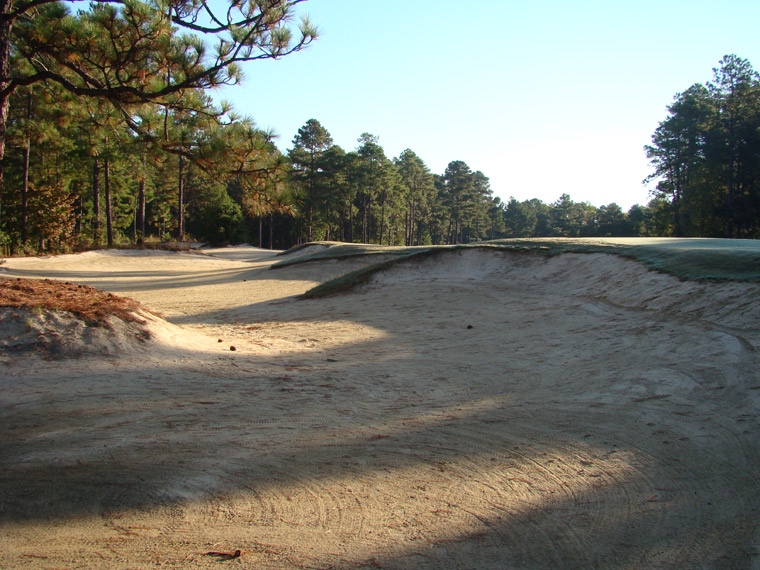
Playing near this 220 yard expanse of sand from the ninth tee provides the best path down the hole.
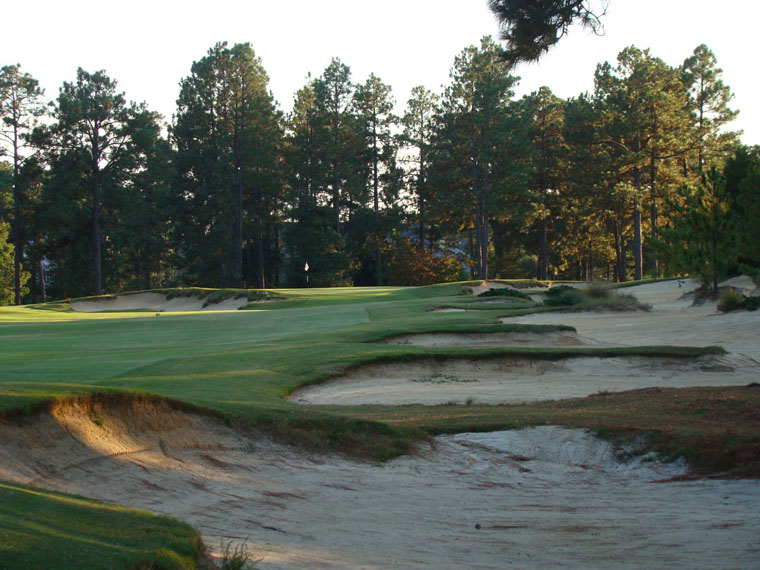
This long one near the eighteenth green captures errant layups.
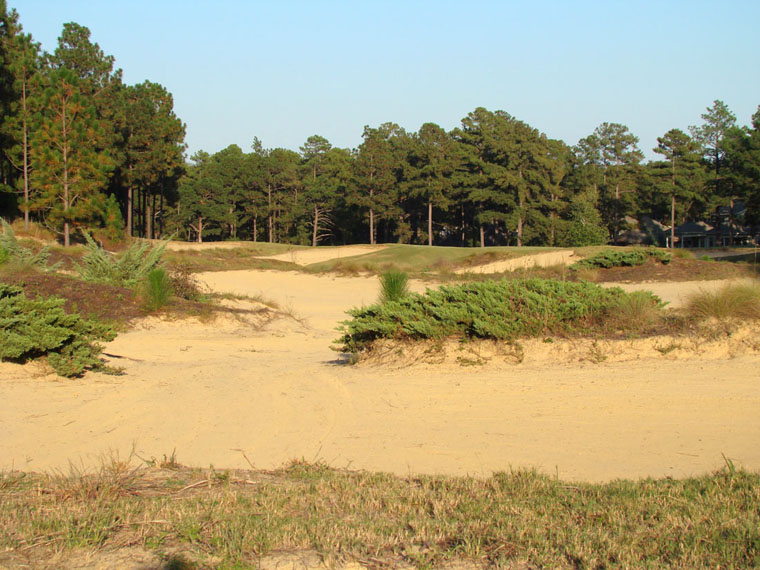
A forced carry to a blind landing area is required off the thirteenth tee.
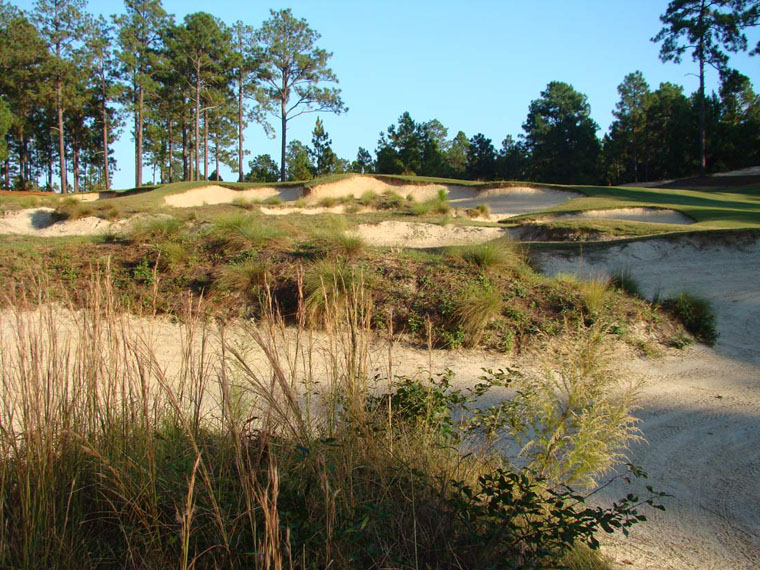
By all means, stay away from the course’s deepest greenside bunker, which extends seventy-five yards back from the twelfth green.
In addition to featuring burlier hazards than the South Course, the North is also some 115 yards longer, measuring 7,210 yards. The yardages below are from the more human tees and total 6,700 yards. After suffering drives into the up-slopes found on holes six, seven, ten, eleven, twelve, and eighteen, you might even find the course more pleasurable at 6,250 yards.
Holes to Note
Third hole, 520 yards; All sorts of things have changed in golf course architecture since Tom joined his uncle in 1963, especially the equipment one now uses to play the game. Lending integrity to par fives is especially challenging in light of 460cc drivers and hot three woods. Forcing a golfer to shape the ball off the tee and producing difficult greens are superior tactics to combat the march of technology.
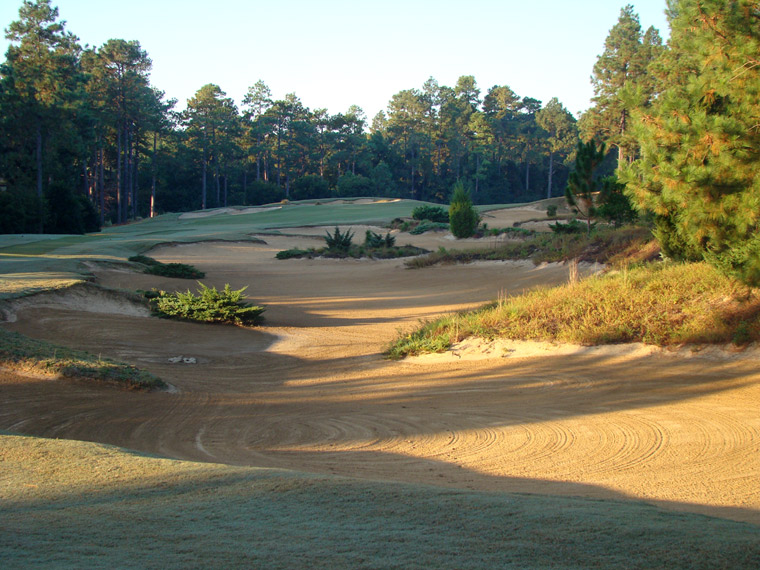
If the golfer is insistent on hitting a driver off the third tee, he will need to hit a power fade to find the fairway which swings to the right.
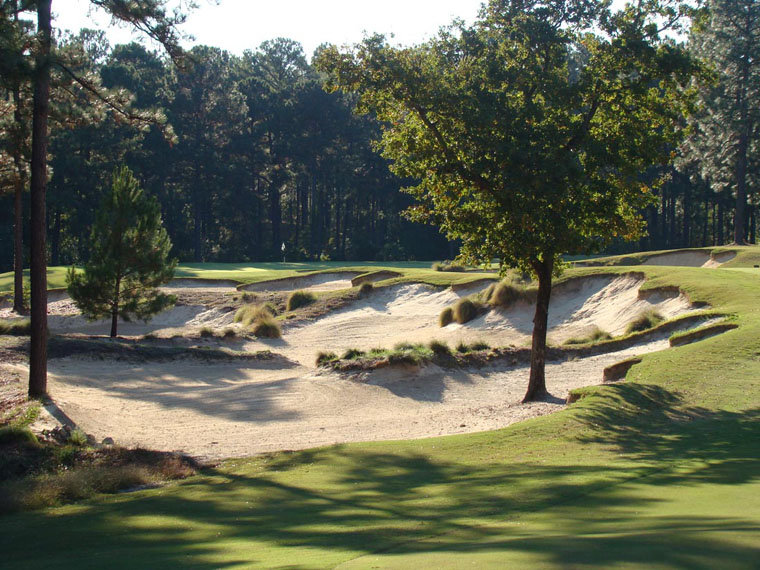
A perfectly shaped drive opens up the possibility of going for the green in two. The only thing that aids the golfer is that his approach will be down the length of the green from this angle.
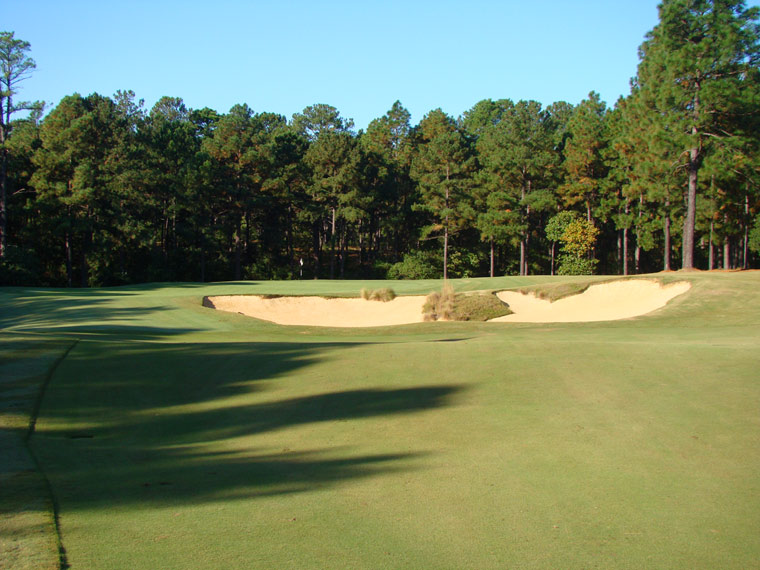
However, most will lay up to the right and then face this 100 yard pitch to a built-up green pad angled from front left to back right. Judging the green’s angle is visually problematic, in part because the front right bunker flairs away from the green toward the golfer.
Fifth hole, 410 yards; One of the best holes on the Forest Creek property is this lengthy two shotter. Given the grand feeling from teeing off up high and seeing a wide tumbling fairway below, most golfers instinctively reach for their driver. Alas, the going is more complicated than that as a well placed bunker left off the tee poses the intended conflict of laying-up with a three wood versus risk getting tangled in it by hitting a driver. The green, which is one of the more confounding ones on the course, starts as an extension of the fairway and then acts in every possible manner to shed golf balls.

The long vista down the fairway with the sixth rising back uphill in the distance gains the golfer a good sense of the up and down nature of the property.
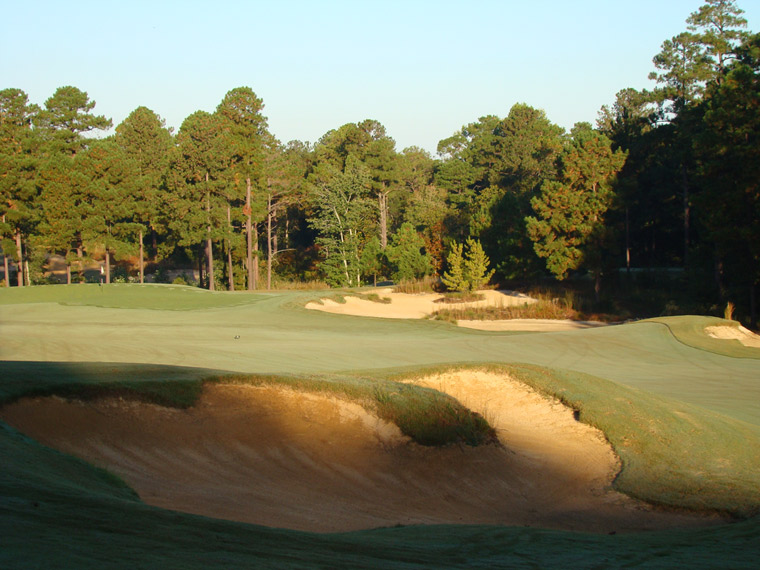
The steep face to this bunker that is 155 yards from the green is such that reaching the green is an unlikely prospect from it. Up ahead is one of the three greens on the course that accepts a running approach shot.
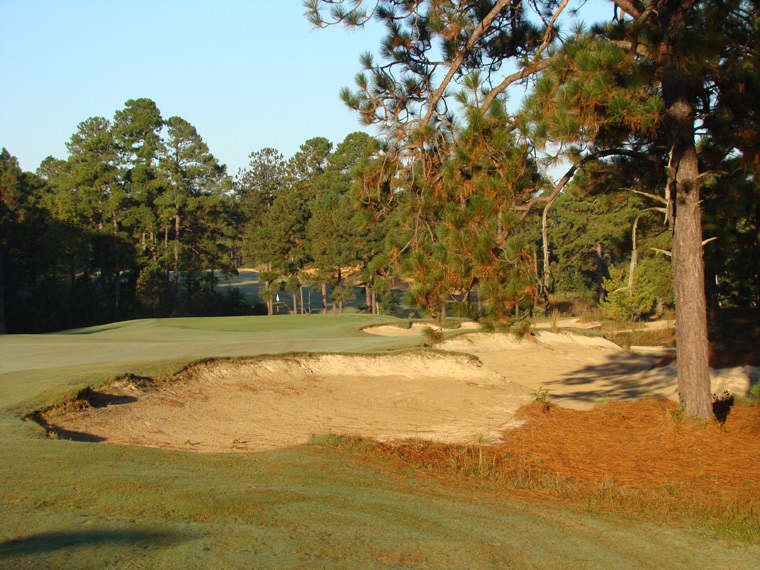
Tee balls that hit right of center are shunted farther right to disadvantaged positions.
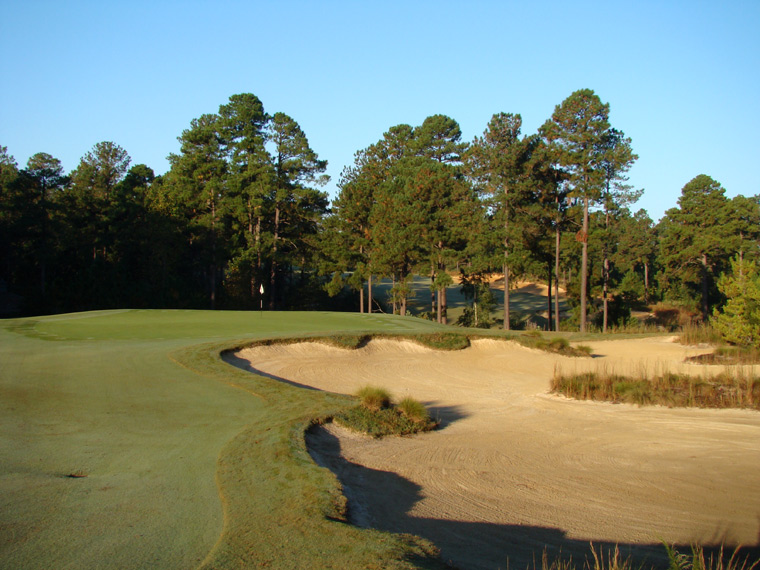
As seen from the right rough, a spine crosses the front third of the fifth green. Beyond, shallow depressions both left and right funnel balls off the putting surface. Whenever the high points of a green are located in its mid section, count on challenging – though deceptively easy to the eye – hole locations such as today’s one.
Sixth hole, 360 yards; At the Home of Golf, otherwise known as Scotland, bunkers are generally smallish in size. Why? Try maintaining a formalized bunker that is 50 or 100 yards long after a wind/rain storm. Large scale bunkers first gained popularity in world golf in the famed sandbelt region of Australia when Alister MacKenzie and Alex Russell among others proved adept at creating large sprawling sandy hazards. Architects like Dick Wilson and then Pete Dye carried the torch for a while at places like Pine Tree and Harbour Town. Eventually, architects got to work on naturally sandy properties. Subsequent bunker achievements at Sand Hills and Pacific Dunes set a new, exciting standard. Tom Fazio was certainly part of the mix too with some of his Florida designs, most notably his world class design at the Pine Barrens course at World Woods. First is often times best though and that may be the case based on the superlative hazards found on MacKenzie’s West Course at Royal Melbourne whereby the bunkers are used in concert with short grass to form compelling strategic holes. Here at the sixth at Forest Creek is a similar classic configuration with the 125 yard long bunker right off the tee in perfect tandem with the solitary greenside one on the left. The short grass to the sides of the green complex might actually be more villainous than the bunker itself, especially for the good player.
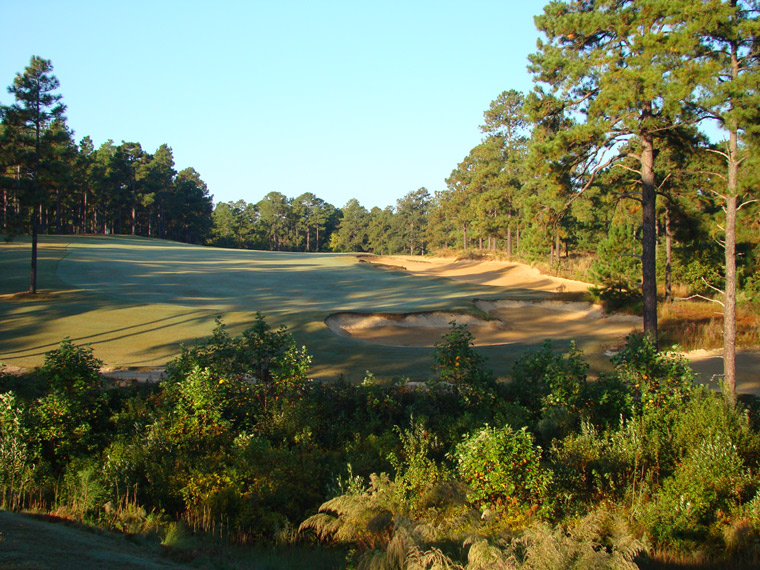
The first of several blind drives, the golfer can’t automatically tell that his interests are best served by playing down the right along the hazard.
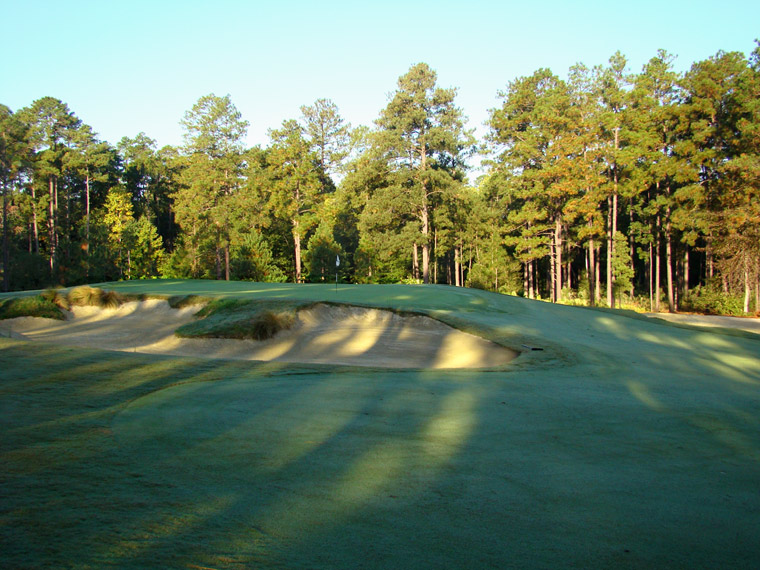
The graceful green complex features plenty of short grass with clean lines behind. While the photograph is taken from the left rough, note how the green opens up to approach shots played from the right (i.e. near the long hazard).
Seventh hole, 425 yards; This blind tee shot is another example that busts the Fazio stereotype, the long driver a) won’t see his tee ball finish over the crest of the hill and b) is befuddled as to how to play his approach shot to a green that ever runs away. Long holes rarely require such a level of finesse on approach shots and it is a pleasure to watch the drama unfold from the crest of the hill as one’s golf ball slowly creeps along the ground/putting surface.
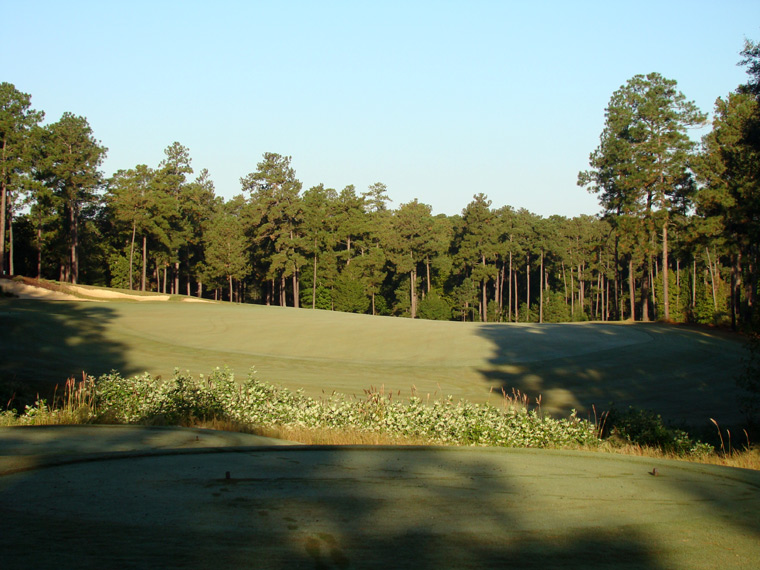
Those that can carry the ball 240 yards from the blue tees enjoy the added advantage of getting a downhill kick off the far side of the hill.

The seventh green drops two feet from front to back and figuring out where to land one’s approach shot is as fascinating on the hundredth play as the first.
Eighth hole, 430 yards; Not all sandy areas are created equal. Sometimes the golfer does well not to shy too much away from some hazards because other hidden penalties are lurking. Such is the case here. Assuming one is playing the set of tees commensurate with ability, this green is difficult to reach in regulation. In fact, it becomes impossible to reach if one plays to the outer edge of the fairway on this dogleg right. Consider the large, 150 yard long sandy area right: it is flat, not deep, and a clean lie is likely enough. It also represents the shorter way home. Though not as beneficial as being in the right side of the fairway, one could lie much worse off the tee than here.
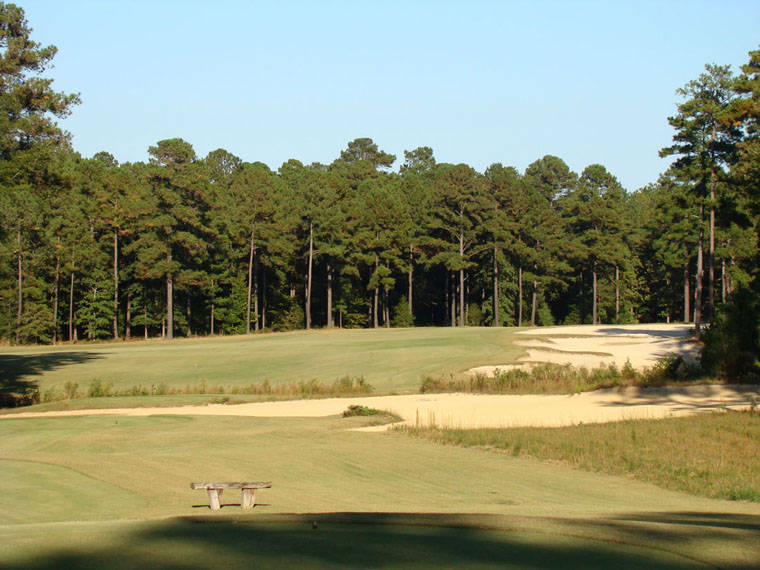
Green Keeper Bill Patton deserves credit for achieving this perfect hue to the eighth fairway.

This large sandy area is not necessarily a bad miss off the tee. Note all the short grass before and right of the green. In fact, it extends fifty yards to the right, melding in with the ninth tees.
Tenth hole, 530 yards; A flat, boring green on a straightaway three shotter like this one might act like a get out of jail Monopoly card. Slash it on your first and/or second shot, and a featureless green holds little recompense. Instead, similar to the green complex at the par five third, this small angled one puts a premium on getting the ball into proper position in two.
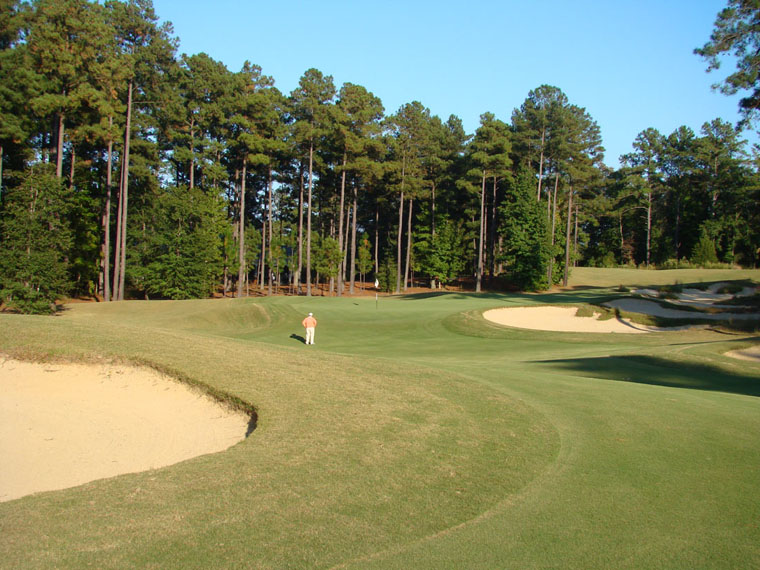
As measured by the height of the golfer, the angled tenth green features a severe false front and numerous difficult back hole locations. Anything more than a short iron approach is likely to meet resistance.
Twelfth hole, 385 yards; Fazio’s body of work shows that he and his clients prefer to route their courses so that more holes play downhill than up and he accomplishes this with uphill walks/cart drives between greens and tees. That isn’t true at the North Course where the sixth, tenth, eleventh and especially the twelfth all feature significantly uphill drives. These features provide the golfer a clear appreciation of the rolling topography over which the eighteen holes were draped. The brute twelfth becomes a visual delight courtesy of a massive greenside bunker but it’s the severely sloped putting surface complete with false front that makes it the toughest par on the course.
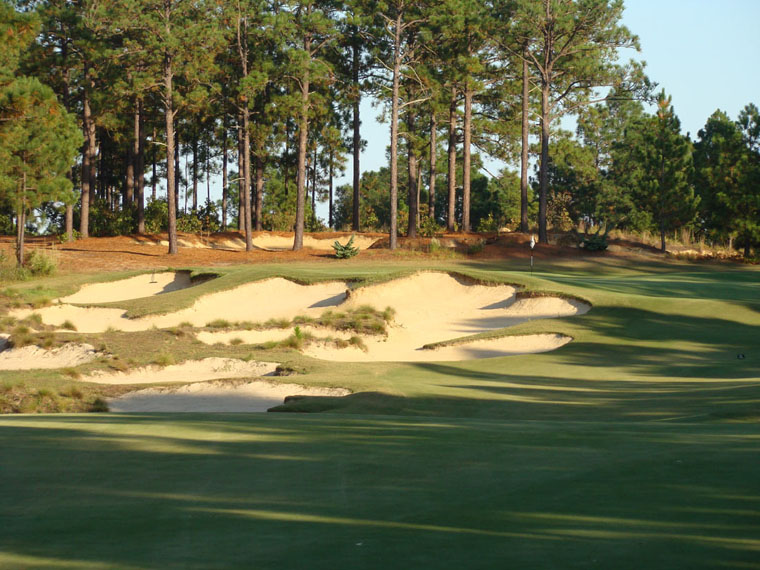
This hole could have easily been a long dreary slug up a gradual slope if it weren’t for the biggest and deepest greenside bunker complex on the course.
Thirteenth hole, 350 yards; Not unlike the eighth at Pine Valley where Tom Fazio is the consulting architect, this short two shotter hole features a blind drive over the crest of a hill to a sloping fairway. Where one should position his tee ball is open for debate: Bust one long down the slope and be left with a fifty yard flip or lay back right middle with a three wood where level lies are more plentiful? The difficulty of an approach shot played from a squirrely side slope is exacerbated here because the green runs away to the rear. Sloping stances produce thin shots with startling regularity and this green’s slope whisks poorly struck balls toward the rear third of the green, whether the golfer wants to be there or not. Putts played from the back of the green generally come up woefully short as the American golfer is unaccustomed to a green that slopes toward the rear (i.e. that putts uphill from the back).

Uncertainty off the tee clouds the issue on this short two shotter.
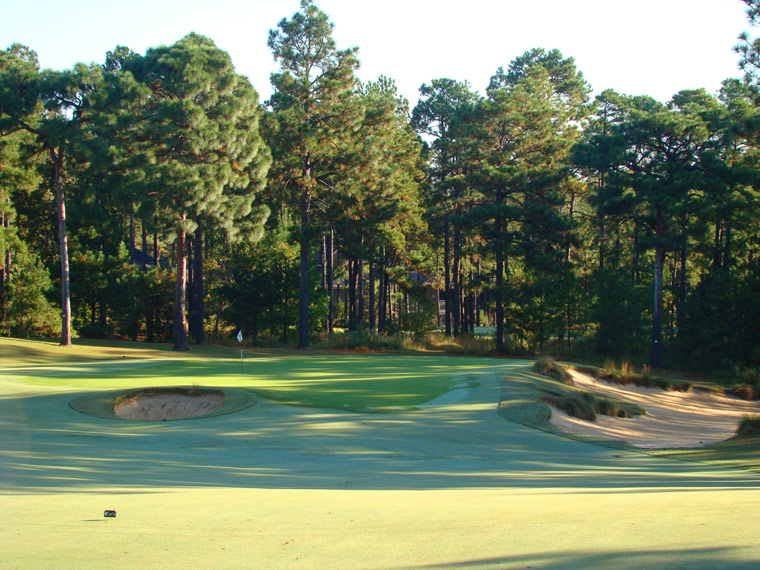
Look all you want but discerning this green’s front to back slope is impossible. For a course replete with large bunkers, the small pit in front of the thirteenth green may actually be the most difficult from which to recovery, a fitting penalty to find on a short two shotter.
Fourteenth hole, 180 yards; Artful in appearance, the challenges on a well-designed Fazio hole are sometimes less discernible. Take a look at the photo below. The green appears walled off suggesting that long is best. Wrong! Look again and note the clearly visible putting surface. On a relatively level hole like this, such a view indicates indicates that the green slopes sharply toward the player. Shots long will roll down a tight bank and leave recovery shots that are difficult to get within fifteen feet of many hole locations.

The one shot fourteenth is a sleeper where many more bogeys are carded than one might suspect.
Fifteenth hole, 405 yards; The Dogwood Course at the nearby Country Club of North Carolina caused a stir when it opened in 1963 because it combined the elements of the Sand Hills of Moore County with acres of water. This combination was irresistible and is improved upon in this three hole triangle by Fazio’s large bunkering schemes which augment and balance the beautiful eleven acre lake. Used as the primary water source for the North Course, the lakes existense was mandatory. Yet, getting the permit to build it took a while, in part because of concerns raised by a drought in 2002. The delay meant that holes one, two and eighteen were actually open for nearly seven years before the completion of the course. The wait was worth it.
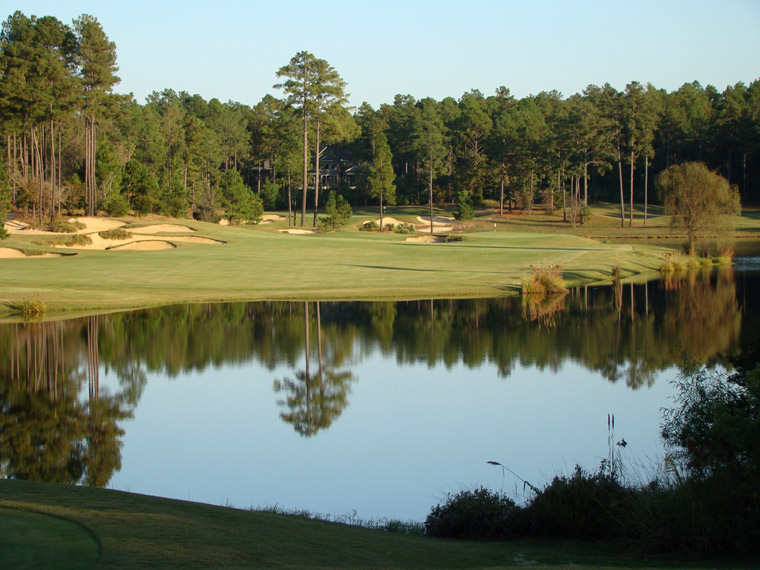
After the fourteenth, the golf transitions into a twenty-five acre open area dominated by a central lake. The sudden introduction of water adds a new element of tension for the golfer while simultaneously making this the most serene section on the 1,200 acre property.
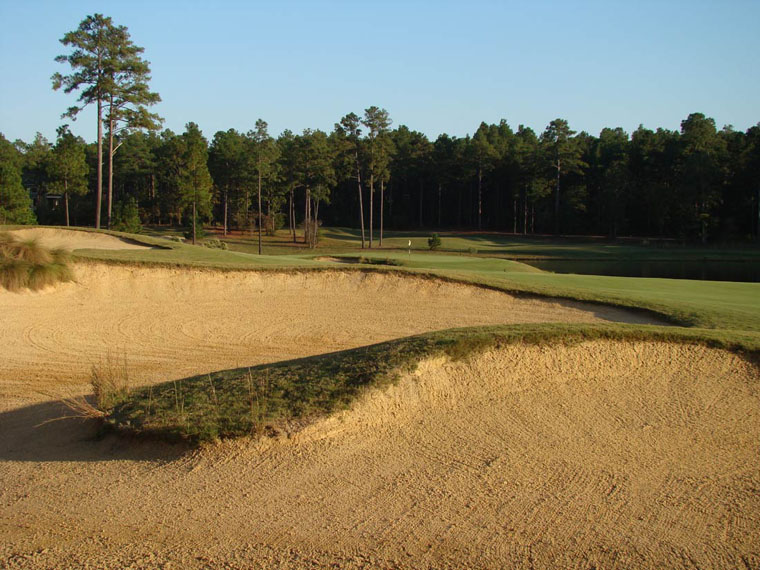
Understandably, many tee balls are tentatively pulled left away from the water. This produces an ugly angle into the green versus ….

… the right side of the fairway (i.e. near the water) whereby the green opens up nicely.
Sixteenth hole, 185 yards; This type one shotter – bunker left, bunker right, green that falls to the front – has been done countless times. What makes this one standout out is its overall setting featuring the rich texture of the pine needles, vegetation, and nearby lake contrasted against the large sandy areas. Though both courses at Forest Creek are real estate ventures, the houses are tucked far back away from play, something that is painfully not true for most of the courses built in the Pinehurst area since Ross’s death.
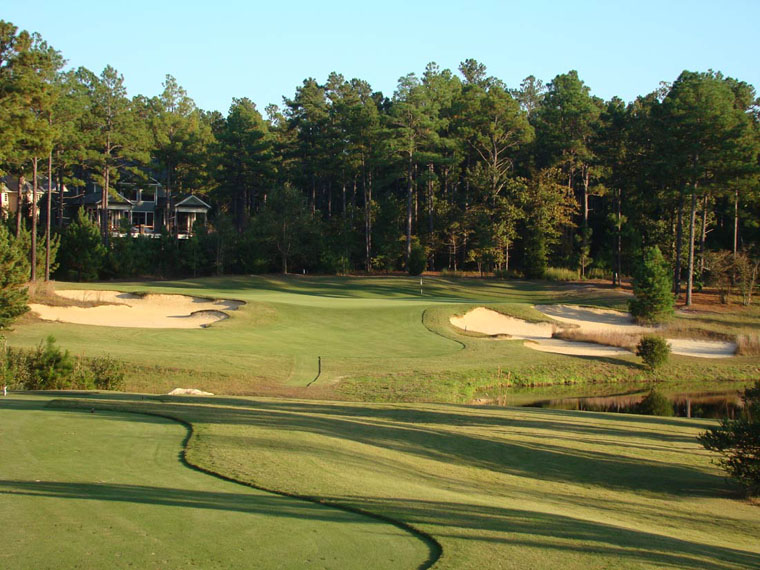
Interesting hole locations are obviously found at the wings of the green and the better golfer will relish the opportunity to shape the ball accordingly. The most sinister hole location is front center as balls just short roll well back and balls long guarantee a swift downhill putt.
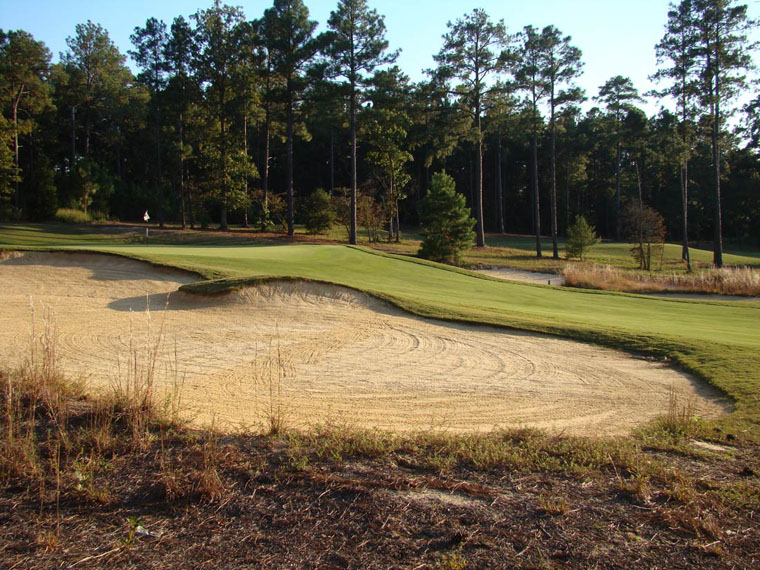
Green Keeper Bill Paton has done a fine job cultivating the North’s rustic charm.
Seventeenth hole, 385 yards; A true cape hole, where the tee and green are threatened by the same hazard. Level lies are afforded in the fairway for tee shots that just sneak around the top of the lower bunker complex. Tee shots played left not only progressively lengthen the second shot but yield a stance with the ball below one’s feet. This dreaded combination produces a weak fade toward the lake and like a Greek tragedy, the outcome is known before the golfer makes his play.
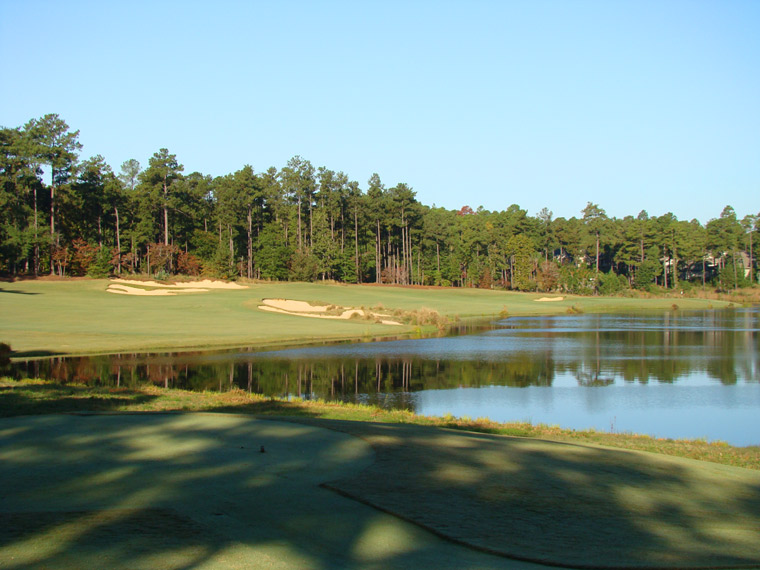
The golfer is free to pick his own line off the seventeenth tee.

The less brave the tee shot, the more the golfer finds himself starring at the lake for his approach shot.
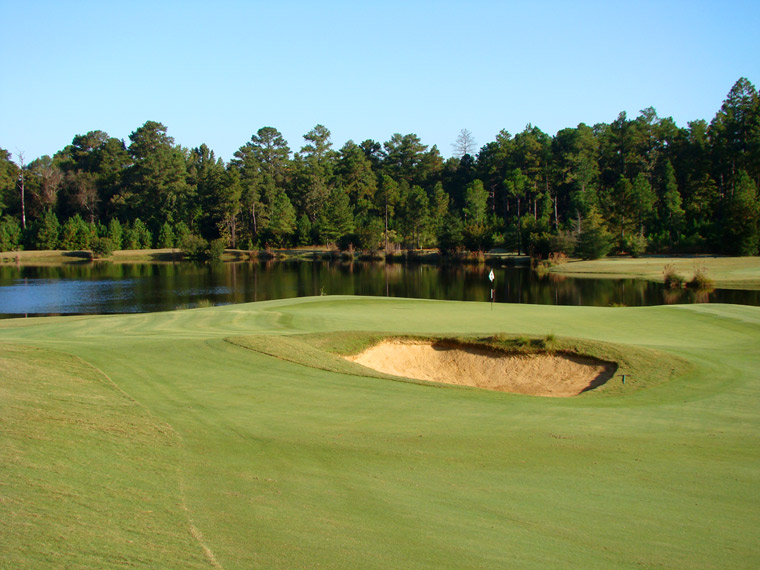
Members routinely settle for the abundant short grass beyond the front left bunker, especially if their approach got wet during their last round. Fazio’s lead design associate Blake Bickford is to be congratulated for the subtle contouring that makes getting up and down problematic from left of the green to any hole location left of center.
The North Course is a difficult course but it ends on an up-beat note with a reachable par five that very well might put the golfer in the mood to walk over to the nearby first tee of the South Course.
Why does the North Course work so well? While it is a real estate course, there is only one substantive 150 yard hike from a green to a tee (sixth green to seventh tee). Though most people prefer to ride in a cart because of the up and down nature of the property, the author has walked the course as many times as he has ridden. Either way, one is left with the impression that the course benefits greatly from not having the front nine return to the clubhouse. Indeed, the eighth tee is as far away from the clubhouse as any point on the course. Unshackled, the architect came up with a meandering routing that takes the golfer up, down and around a fine piece of natural, sandy golf terrain. Fazio’s unconventional sequencing of pars took maximum advantage of the rolling topography. Throw in the large scale bunkers and greens that slope in all manner and you have a course that captures the best of a property rich in golfing features.
Fazio’s vast body of work covers the entire architectural spectrum. At one end, he has been very fortunate to work on properties with many fine natural features including Wild Dunes (before it was savaged by storms), Wade Hampton, Gozzer Ranch and here twice. At Forest Creek the rolling land, scented pines, and sandy soil are ideally suited for golf and he did well to create companion courses that are true to the land while still being different from each other. The members are evenly divided as to which they prefer to play, a sure sign of a job well done. At the other end, Fazio might light up more when discussing projects that were the greater engineering accomplishments, requiring the most earth to be moved. No living architect has undertaken more extensive wall to wall shaping projects like Shadow Creek. Indeed, Tom Fazio is largely recognized as the best architect for such situations.
So how will his disparate book of business be viewed historically? Though his impressive engineering feats and ability to “manufacture” a golf course will always be given accord, it might well be that the courses such as those at Forest Creek will have the most enduring appeal. After all, try as man might, he can never best nature and Fazio’s work at the North Course at Forest Creek indicates an appreciation of that most important design tenet.
The End

